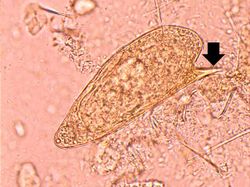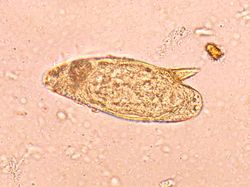Difference between revisions of "IPLab:Lab 11:Schistosomiasis"
Seung Park (talk | contribs) (→Journal Articles) |
Seung Park (talk | contribs) (→Images) |
||
| Line 21: | Line 21: | ||
=== Images === | === Images === | ||
| − | + | * [http://peir.path.uab.edu/library/index.php?/tags/2164-schistosoma PEIR Digital Library: Schistosomiasis Images] | |
| + | * [http://library.med.utah.edu/WebPath/GIHTML/GIIDX.html WebPath: Gastrointestinal Pathology] | ||
| + | * [http://library.med.utah.edu/WebPath/LIVEHTML/LIVERIDX.html WebPath: Hepatic Pathology] | ||
== Related IPLab Cases == | == Related IPLab Cases == | ||
Revision as of 04:47, 25 August 2013
Contents
Clinical Summary[edit]
This 30-year-old white male was admitted to the hospital following an upper gastrointestinal hemorrhage with repeated hematemesis. On admission he was tachycardic and had orthostatic hypotension. Endoscopy revealed the presence of esophageal varices. Following fluid replacement and control of bleeding, the patient appeared well. Careful physical exam revealed a palpable spleen extending to the umbilicus. Ascites was not present. The hematocrit was 27%, the white count 12,000 with 30% eosinophils, and the platelet count 98,000. The patient denied alcohol use and had no history of hepatitis. However it was found that two years prior to admission he had worked as a Peace Corps volunteer on a fish-farming project in Ghana. He had been generally healthy while in Africa. He could recall only a fever and cough lasting two or three days, and a brief episode of fever, chills, and headache which was empirically treated as malaria, although no parasites were seen on a single peripheral smear at the time. Since his return to the U.S. eighteen months ago, he had been in good health, but had occasionally noticed some vague left upper quadrant discomfort. Examination of the stool for ova and parasites revealed a few Schistosoma mansoni eggs.
Images[edit]
Study Questions[edit]
Additional Resources[edit]
Reference[edit]
- eMedicine Medical Library: Schistosomiasis
- eMedicine Medical Library: Emergent Management of Acute Schistosomiasis
- Merck Manual: Schistosomiasis
Images[edit]
- PEIR Digital Library: Schistosomiasis Images
- WebPath: Gastrointestinal Pathology
- WebPath: Hepatic Pathology
Related IPLab Cases[edit]
| |||||
Hematemesis is the vomiting of blood.
Cirrhosis is a liver disease characterized by necrosis, fibrosis, loss of normal liver architecture, and hyperplastic nodules.
Hematuria is the presence of blood in the urine.
Hydronephrosis is dilation of the renal pelvis and atrophy of the cortex due to increase pressure from retained urine.


